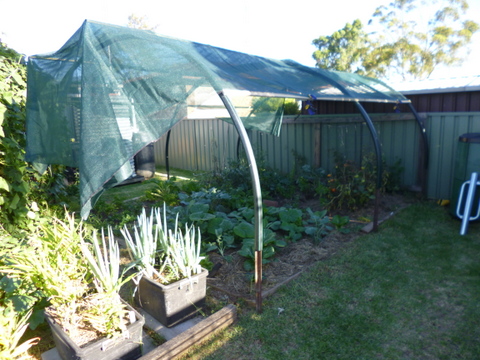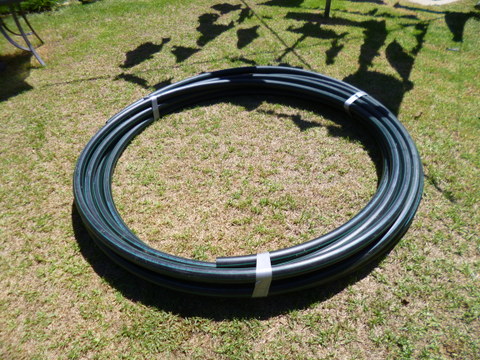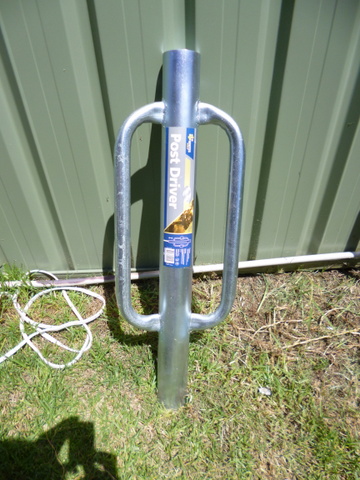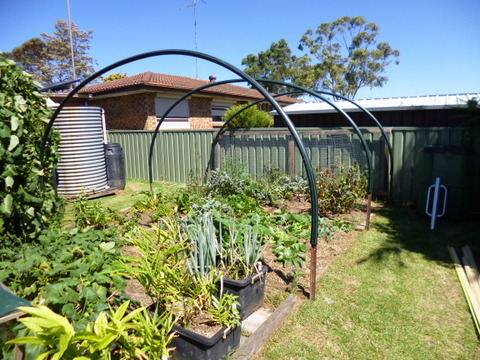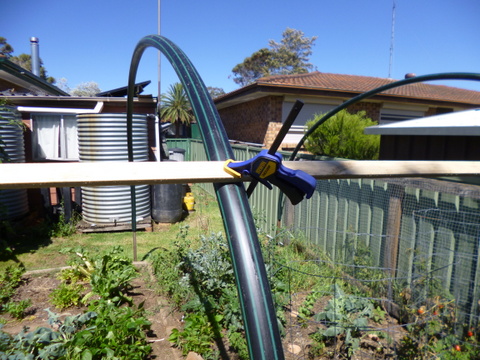The summers here in western Sydney seem to be getting hotter, and the numbers (number of hot days, length of hot spells, highest temperatures) definitely back that impression up. It can be hard to keep the garden going, let alone producing, in the hot dry conditions we have experienced lately. The ollas have helped to keep the water were it needs to be, in the beds that have them but the long, strong afternoon sun takes a heavy toll on the plants. Seeing as it was a bad year this year and all the gurus say that global warming will only make things worse I decided to do something about it.
I obviously needed to put some protection between the fierce afternoon sun and the veggies, but the question was… how? It took some time to get the design right, because my original design followed the one my father put in place many years ago. He used to grow orchids and had built a huge shade house that took up half of our fairly generous back yard. He built most of the structure out of 25mm (or 1” as it would have been then) galvanised water pipe. It was strong and durable and comparatively cheap and easy to build. Perfect!
We it was perfect until I tried to get hold of some 25mm water pipe! If I wanted it in one metre lengths I could walk right into Bunnings and get as much as I wanted, but I wanted four to six metre lengths, plus fittings. To get hold of that stuff was almost impossible second hand (there was some 50mm stuff available but very heavy and very pricey) and the stuff was expensive with a capital “E”! So after some months of trying to work out a design I decided it didn’t need it to survive a nuclear blast and I would have to use something lighter (and cheaper!).
The new design was based around poly pipe, star posts and some timber.
Components
When we had a dog, and before the chook tractor, I used lots of star posts to make fences around the veggie patches and the chook area to separate the livestock from the crops. When the fences came down I kept the star posts in the shed, some were 1350mm and others were 1800mm so at least I didn’t need to buy any. In any case they are easily available and sometimes you can pick them up second hand.
To make the overhead bows that would support the shade cloth I am using 50mm (nominal) green stripe polypipe. To work out how much I needed, I measured the distance I needed to cover (in this case almost 4 metres) which gave me the diameter of a theoretical circle. By multiplying the diameter by π and then halving it I could calculate an arc that would do the trick, it came out to roughly 6 metres, so that is what I went with.
Unfortunately many suppliers want you to buy a whole 100m roll and are unwilling to cut lengths off for you, particularly hardware and produce merchants in my experience. I wanted 6 x 6 metre lengths to make 6 bows but I was eventually able to buy a cut 36 metre length from a rural irrigation supplier. This stuff is big and I had to hire a ute to bring it home in but that worked out much cheaper than home delivery and there was NO WAY is would have fitted into my little Suzuki Alto!
The battens to hold the hoops together and support the shade cloth and allow it to be attached to the structure are 20mm x 42mm treated pine. For the back veggie patch I needed timber about 4.5 metres long to go the distance in one go and the stuff came in 4.8 metre lengths which worked out pretty well. Transport was a bit problematic so I used the same ute which we hired to pick up the poly pipe.
Shade cloth effectiveness is measure by how much light the shade cloth blocks out, hence 90% shade cloth only lets through 10% of the light. While I wanted to break the strong sunlight down a bit I didn’t want to block out the light almost completely and get leggy plants that were not productive. To that end I got hold of a roll of 50% shade cloth and it seems to work pretty well, allowing the plants to keep growing in the hot weather without stopping them from developing normally.
Putting it all together
Measuring the polypipe out is a bit of fun, the stuff can be fairly stiff so a warm sunny day helps to soften the plastic. It is also handy to have another person to stretch out the pipe straight and hold the end of the tape measure while you measure out the right length. Once you have the pipe stretched straight out and measured it is easy to cut to length with a hand saw.
Putting in the star pickets can be easy or difficult. I have tried hammering them in with a club hammer, a sledge hammer and a claw hammer and they all fit into the category of “difficult”. I recently got hold of a tool specifically designed to install star pickets, a post driver. It is basically a galvanised pipe with handles (see photo) and you lift it over the post and ram it down to drive it into the ground. It works very, very well, but is somewhat noisy if you are going to do more than a few at any one time I would recommend hearing protection of some sort.
In designing the cover I had to take into account the chook tractor and ensure that the distance between the star pickets would be enough to allow the chook tractor to be manoeuvred between them. The chook tractor is about 2 metres long so I allowed about 2.5 metres between the star pickets for the back veggie patch where I would have to take it through sideways. In building the front one, I have access to the front end of the patch so I can take the chook tractor in end-on so in this case the distance between was not critical and I opted for 1.5 metres (one at each end of the patch and one in the middle.
Most of the star pickets I had were of the 1350 mm long variety so I basically pounded them in until the post driver hit the ground, leaving about 770mm out of the ground which meant that there was over half a metre of star post in the ground. That seems to have worked pretty well.
It is possible to fit the hoops over the star by yourself but having another person helps! Once the hoops are over, pull them down until they have gone as far down the star pot as they will, for me that turned out to be when the end was still 450-500mm off the ground. That coupled with the bow of the 6 metre poly pipe meant the height under the middle of the bow is a bit over 2 metres.
At this point I needed to affix the battens to the polypipe. To be absolutely sure I got the length right I measured it at the bottom of the star pickets rather than the bows, which are flexible and will move around a bit. With the two outside battens cut to size I fitted them by drill a hole and countersinking it, then drilling in one screw into each batten. I left the top two full length to form a bit of an overhang for the shadecloth. I also had to make sure that the battens were high enough for the chook tractor to fit under them. Another factor was that the shade cloth was 3600mm wide, so the outer battens on each side could not be further apart than that or I wouldn’t be able to attach one side.
With the battens in place I pulled the shade cloth up and over the top of the structure so that the south end was level with the last bow and the north end hung down by about 1500mm to give extra cover against the hot northerly midday sun. To affix the shade cloth to the battens I used “Cooleroo” Timber fasteners. Just pull the shade cloth down over the end batten on each side and hammer a timber fastener (a metal rectangle painted green with 8 projections that stick into the wood) in every 200mm. This secured the shade cloth cheaply and effectively.
How Does it Work?
It made an immediate difference to the feel of the veggie patch, it was much more pleasant to walk around underneath. I have had problems with poor growth of some veggies (brassicas, celery) which were planted during the hotter times or were in full sun for most of the day. I think next year will be better even if it is as hot as this year has been.
One interesting side effect has been that I have not needed to water quite as much in the plots where I don’t have ollas. On the down side, we have had some rain lately and when it is only light rain there is a tendency for some of it to collect and run off the sloping side panels of shade cloth, reducing the amount of rainwater getting to the veggies. Fortunately we have just had a day of heavy rain and everything is well and truly rehydrated.
In half a day I was able to put up a cover over a veggie patch 4500mm x 4000mm almost by myself and it is guaranteed to increase production next year so it is a worthwhile project for anybody to have a go at.



